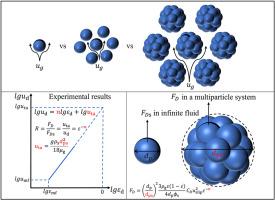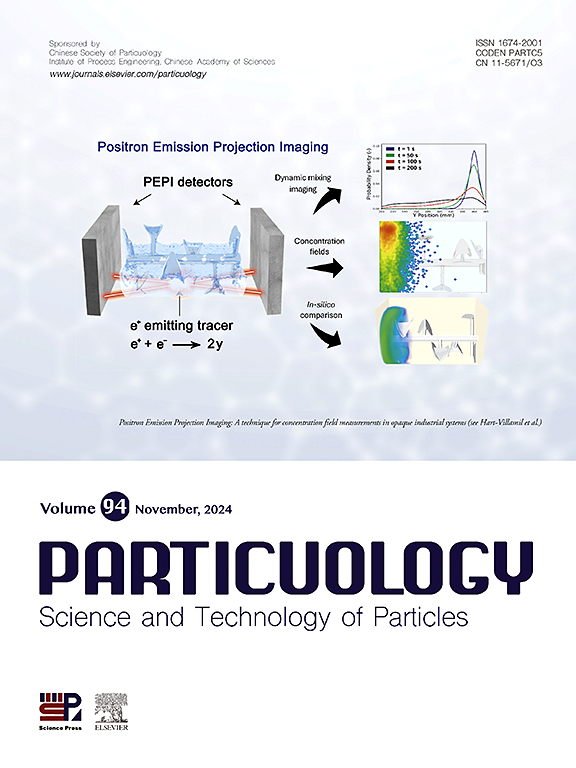纳米调制 C 组颗粒流化的修正阻力模型
IF 4.1
2区 材料科学
Q2 ENGINEERING, CHEMICAL
引用次数: 0
摘要
Geldart C 族粉末由于粒子间的强大作用力而具有固有的内聚性,导致严重的团聚和流化能力差。本研究对纳米调制的 C 族颗粒的流化进行了数值研究。这些颗粒也称为 C+ 组颗粒,是通过纳米颗粒调制技术获得的,该技术将一小部分纳米颗粒与 C 组颗粒剧烈混合,使其附着在大得多的 C 组颗粒表面。改性后,C+ 组颗粒的内聚力明显减弱,因此这些颗粒的流化质量大大提高。然而,仍然存在的内聚力导致系统内部形成了小团聚。为了了解 C+ 组颗粒的内部团聚机制及其对流化行为的影响,我们根据实验结果和颗粒团聚假设提出了一个新的阻力模型。在总膨胀和密相膨胀方面,采用新阻力模型的数值结果与实验数据非常吻合。这些发现揭示了与改性 C 组颗粒相关的阻力机制,有助于理解超细颗粒流化。本文章由计算机程序翻译,如有差异,请以英文原文为准。

A modified drag model for the fluidization of nano-modulated Group C particles
Geldart Group C powders are inherently cohesive due to the strong interparticle forces, leading to severe agglomeration and poor fluidization capability. In this study, fluidization of nano-modulated Group C particles was investigated numerically. These particles, also known as Group C+ particles, were obtained through the nanoparticle modulation technique, with which a small fraction of nanoparticles were vigorously mixed with Group C particles so that they are adhered to the surface of the much larger Group C particles. After modification, the cohesiveness of Group C+ particle was significantly weakened, and therefore these particles could exhibit much better fluidization quality. However, the still existing cohesion resulted in the formation of small agglomerates within the system. To understand the internal agglomeration mechanisms of Group C+ particles and their impact on fluidization behaviors, a new drag model was proposed based on experimental results and the postulation of particle agglomeration. The numerical results of the cases employing the new drag model agreed well with the experimental data in terms of total and dense phase expansion. These findings revealed the drag mechanism associated with modified Group C particles, contributing to the understanding of ultrafine particle fluidization.
求助全文
通过发布文献求助,成功后即可免费获取论文全文。
去求助
来源期刊

Particuology
工程技术-材料科学:综合
CiteScore
6.70
自引率
2.90%
发文量
1730
审稿时长
32 days
期刊介绍:
The word ‘particuology’ was coined to parallel the discipline for the science and technology of particles.
Particuology is an interdisciplinary journal that publishes frontier research articles and critical reviews on the discovery, formulation and engineering of particulate materials, processes and systems. It especially welcomes contributions utilising advanced theoretical, modelling and measurement methods to enable the discovery and creation of new particulate materials, and the manufacturing of functional particulate-based products, such as sensors.
Papers are handled by Thematic Editors who oversee contributions from specific subject fields. These fields are classified into: Particle Synthesis and Modification; Particle Characterization and Measurement; Granular Systems and Bulk Solids Technology; Fluidization and Particle-Fluid Systems; Aerosols; and Applications of Particle Technology.
Key topics concerning the creation and processing of particulates include:
-Modelling and simulation of particle formation, collective behaviour of particles and systems for particle production over a broad spectrum of length scales
-Mining of experimental data for particle synthesis and surface properties to facilitate the creation of new materials and processes
-Particle design and preparation including controlled response and sensing functionalities in formation, delivery systems and biological systems, etc.
-Experimental and computational methods for visualization and analysis of particulate system.
These topics are broadly relevant to the production of materials, pharmaceuticals and food, and to the conversion of energy resources to fuels and protection of the environment.
 求助内容:
求助内容: 应助结果提醒方式:
应助结果提醒方式:


